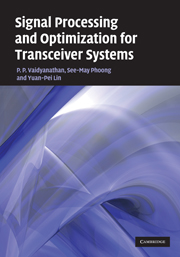Book contents
- Frontmatter
- Contents
- Preface
- Acknowledgements
- Part 1 Communication fundamentals
- 1 Introduction
- 2 Review of basic ideas from digital communication
- 3 Digital communication systems and filter banks
- 4 Discrete-time representations
- 5 Classical transceiver techniques
- 6 Channel capacity
- 7 Channel equalization with transmitter redundancy
- 8 The lazy precoder with a zero-forcing equalizer
- Part 2 Transceiver optimization
- Part 3 Mathematical background
- Part 4 Appendices
- Glossary
- Acronyms
- References
- Index
7 - Channel equalization with transmitter redundancy
from Part 1 - Communication fundamentals
Published online by Cambridge University Press: 05 August 2011
- Frontmatter
- Contents
- Preface
- Acknowledgements
- Part 1 Communication fundamentals
- 1 Introduction
- 2 Review of basic ideas from digital communication
- 3 Digital communication systems and filter banks
- 4 Discrete-time representations
- 5 Classical transceiver techniques
- 6 Channel capacity
- 7 Channel equalization with transmitter redundancy
- 8 The lazy precoder with a zero-forcing equalizer
- Part 2 Transceiver optimization
- Part 3 Mathematical background
- Part 4 Appendices
- Glossary
- Acronyms
- References
- Index
Summary
Introduction
In this chapter we consider the effect of introducing redundancy into the symbol stream at the transmitter of a digital communication channel. The introduction of a sufficient amount of redundancy helps to equalize the channels more easily. For example FIR channels can be equalized with FIR filters without the need for oversampling at the receiver as in Secs. 4.7–4.8. Two types of redundancies will be discussed here. The first one, discussed in Sec. 7.2, is zero padding (ZP), where a block of zeros is inserted between adjacent blocks of input samples. The second one, studied in Sec. 7.3, is called cyclic prefixing (CP), where a subset of input samples is repeated in each block. In Sec. 7.4 we show how the CP system can be represented in terms of a circulant matrix. Important variations of cyclic prefix systems such as single-carrier (SC-CP) systems and multicarrier systems, also called orthogonal frequency division multiplexing (OFDM) systems, are discussed in Sec. 7.5. Cyclic prefixing is commonly employed in OFDM systems, and in discrete multitone (DMT) systems used in DSL technology. Some details about the DMT system are discussed in Sec. 7.6.
Zero padding
Figure 7.1 explains the zero-padding operation on a discrete-time signal s(n) (the symbol stream to be transmitted). We divide the signal into blocks of length M and insert L zeros at the end of each block to obtain the zero-padded result x(n), which is then sent over the channel.
Information
- Type
- Chapter
- Information
- Signal Processing and Optimization for Transceiver Systems , pp. 244 - 294Publisher: Cambridge University PressPrint publication year: 2010
